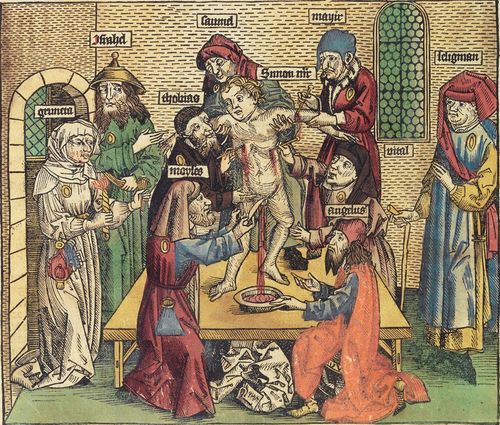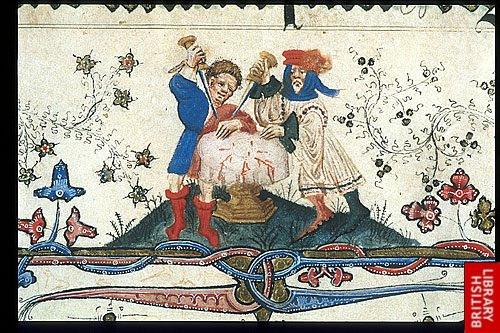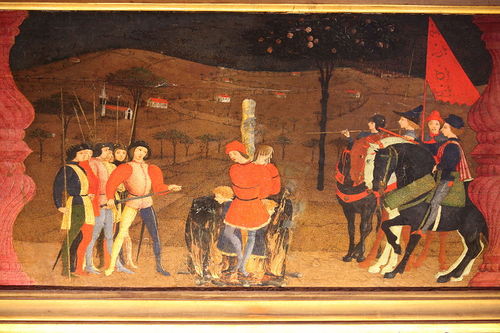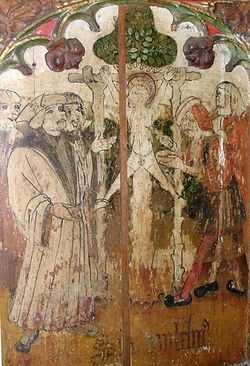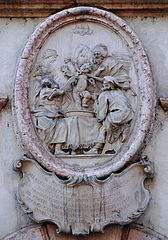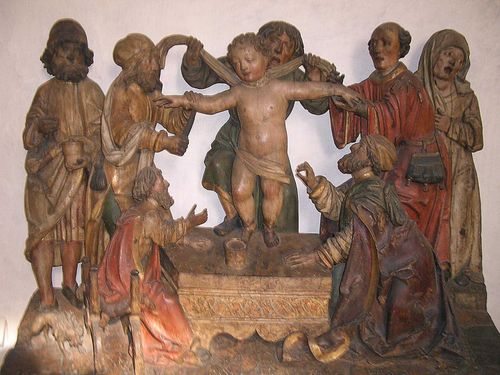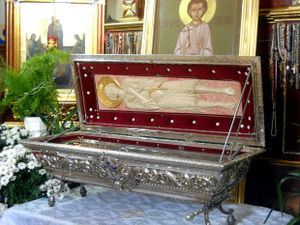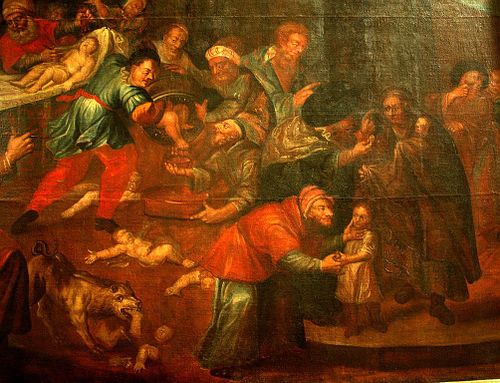Category:Blood Libel (subject)
Blood Libel is the name given to the false accusation that Jews used to kidnap and sacrifice a Christian child for Passover.
Overview
The Middle Ages saw the spreading of malicious prejudices against the Jews. They were falsely accused of kidnapping Christian children for bloody sacrifices (Blood Libel). As it was believed that Jews had murdered Christ, so Jews' intention was to repeat the suffering of the Christ. The murdered Christian child was the image of Christ. According to the public imagination, the child was tortured and killed in a manner imitating the Crucifixion of Jesus.
A Catholic Variant: Host Desecration
The same kind of intent is at the origin of another medieval myth. In Catholic countries, the consecrated host was believed to be the body of Christ. Jews were falsely accused of acting against the body of Christ (Host Desecration), stabbing and piercing the host to get the blood.
Crime and punishment
As a result, thousands of Jews were persecuted, murdered, condemned to the stake:
As Jews were collectively held responsible for the death of Christ, it was not considered unjust that Jewish children also should pay the price. They were condemned to the stake with their parents and relatives.
The Christians' belief that the Jews were at war against their children, made Jewish children particularly vulnerable. It offered a powerful moral justification for any "retaliatory" violence against them.
Some notable historical cases
From William of Norwick (1144) to Hugh of Lincoln (1255)
The case of William of Norwisck is the first known medieval accusation against Jews of ritual murder. The twelve-year-old William was an apprentice tanner who regularly came into contact with Jews and visited their homes as part of his trade. His death was unsolved; the local community of Norwich attributed the boy's death to the Jews, though the local authorities would not convict them for lack of proof. William was shortly thereafter acclaimed as a saint in Norwich.
The story of William of Norwick influenced another similar stories, all involving the death of young boys supposedly murdered by Jews during Easter time: Harold of Gloucester (1168), Robert of Bury (1181), until Hugh of Lincoln (1255).
The last case is significant, because it was the first time that the Crown gave credence to ritual child murder allegations, through the direct intervention of King Henry III. As a result, almost 100 Jews were prosecuted, and many executed.
From Werner of Oberwesel (1287) to Simon of Trent (1475)
Prompted by news of the blood Libel in England, a similar story erupted when a sixteen-year-old boy, Werner of Oberwesel, was found dead in 1287 in Germany.
The alleged murder was followed by a wave of pogroms against the Jewish community. Violence spread from the Middle Rhine to the Moselle and the Lower Rhine region. The Jewish community turned to King Rudolf I, who was convinced the accusations were groundless. He fined the murderers of Jews and ordered the burning of the corpse of Werner in order to prevent any further veneration. The royal instructions were not followed. Werner's body was buried in a chapel and his veneration spread as a martyr cult.
Other important cases were that of Andreas Oxner in Austria and especially that of the three-year-old Simon of Trent in 1475 in Northern Italy (then under Austria). The entire Jewish community (both men and women) of Trent were arrested and forced to confess under torture. At least fifteen Jews were executed and the entire Jewish community left Trent.
At the same time, accusations of host desecration spread against Jews after the Fourth Lateran Council of 1215 defined as the dogma transubstantiation of the host. The first recorded case happened in 1243 at Beelitz, Germany, and then in Paris (1290), Deggerdorf (1337), Brussels (1370), etc. In all these occurrences, the accusation led to executions and massacres of Jews. Starting from the 16th century, however, also in consequence of the Reformation, such accusations gradually disappeared. The last recorded case occurred in Berlad, Romania, in 1836.
Cases of Blood Libel also became less and less common in Western Europe after the Reformation. However, the cult of these martyr children continued and was officially abolished by the authorities of the Catholic Church only after the Holocaust, in the aftermath of the Vatican II Council (1963-65).
From Gabriel of Białystok (1690) to the present
The case of Gabriel of Białystok is particular relevant as it signals the spread of the Blood Libel from central Europe to Eastern Europe (Poland and Russia), and from the Catholic to the Orthodox Church, being now equally shared by Catholic and Orthodox Christians.
The six-year-old Gabriel was believed to have been kidnapped by Jews in the village of Zverki and brought to Białystok, to be ritually sacrificed. In 1755 his relics were transferred to the Monastery of the Holy Trinity in Slutsk near Minsk (Belarus). His cult developed and spread throughout the Russian Empire, and he was canonized in 1820 by the Russian Orthodox Church as the patron saint of children. His cult was suppressed by Soviet authorities in the 1930s but was revived in Belarus and Poland in the 1990s, when his relicts were moved back to Białystok.
Accusations of ritual murder of children remained common in Eastern Europe in the 19th and 20th centuries and fostered the spread of antisemitism in the region. Although the cult of St. Gabriel was suppressed by Soviet authorities in the 1930s, the accusations were believed to be true by the majority of the Christian population at the time of the Holocaust.
The last relevant incident occurred in 1946 at Kielce (Poland), where 42 Jews (and Holocaust survivors) were killed and more than 40 were wounded, in a pogrom following the false rumors that the Jews had kidnapped a Christian boy.
The Blood Libel has not completely vanished. It is still repeated in antisemitic propaganda (especially in Russia and in some Arabic countries). The cult of St. Gabriel was revived in Belarus and Poland in the 1990s, when his relicts were moved back to Białystok.
This category currently contains no pages or media.
